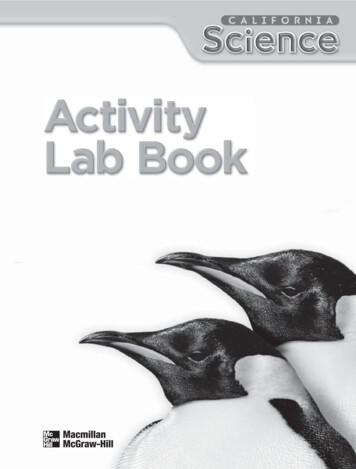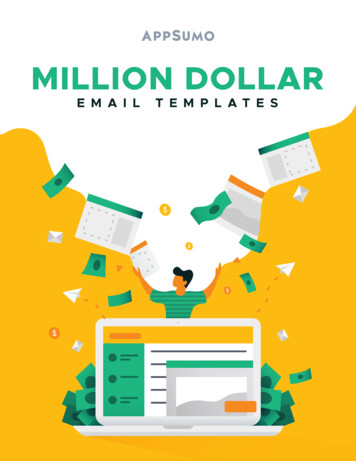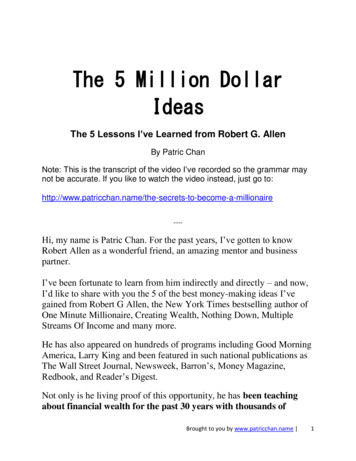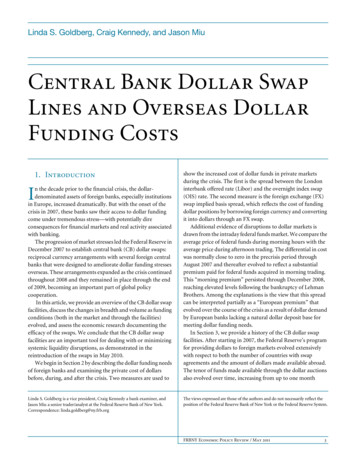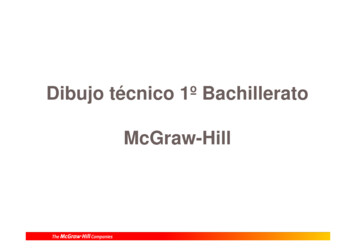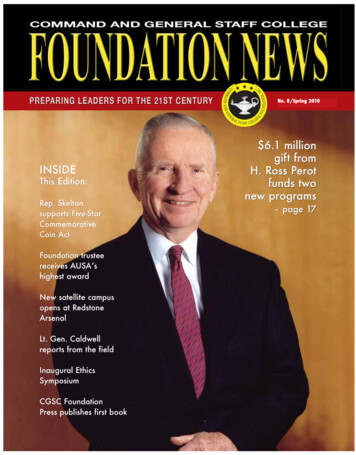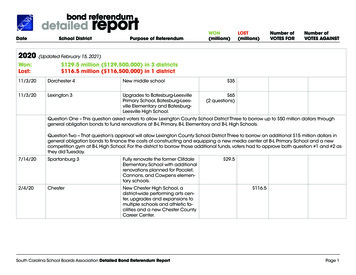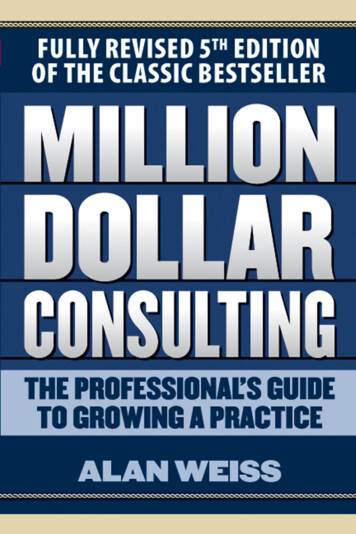
Transcription
MillionDollarConsultingThe Professional’sGuide to Growinga PracticeFifth EditionAlan WeissNew York Chicago San o City Milan New DelhiSingapore Sydney Toronto00-Weiss FM.indd 304/03/16 12:56 PM
Copyright 2016 by Alan Weiss. All rights reserved. Except as permitted under the United States CopyrightAct of 1976, no part of this publication may be reproduced or distributed in any form or by any means, or stored in adatabase or retrieval system, without the prior written permission of the publisher.ISBN: 978-1-259-58862-4MHID: 1-259-58862-9The material in this eBook also appears in the print version of this title: ISBN: 978-1-259-58861-7,MHID: 1-259-58861-0.eBook conversion by codeMantraVersion 1.0All trademarks are trademarks of their respective owners. Rather than put a trademark symbol after every occurrenceof a trademarked name, we use names in an editorial fashion only, and to the benefit of the trademark owner, with nointention of infringement of the trademark. Where such designations appear in this book, they have been printed withinitial caps.McGraw-Hill Education books are available at special quantity discounts to use as premiums and salespromotions or for use in corporate training programs. To contact a representative, please visit the Contact Us pages atwww.mhprofessional.com.This publication is designed to provide accurate and authoritative information in regard to the subject matter covered.It is sold with the understanding that neither the author nor the publisher is engaged in rendering legal, accounting,securities trading, or other professional services. If legal advice or other expert assistance is required, the services of acompetent professional person should be sought.— From a Declaration of Principles Jointly Adopted by a Committee of theAmerican Bar Association and a Committee of Publishers and AssociationsTERMS OF USEThis is a copyrighted work and McGraw-Hill Education and its licensors reserve all rights in and to the work. Useof this work is subject to these terms. Except as permitted under the Copyright Act of 1976 and the right to storeand retrieve one copy of the work, you may not decompile, disassemble, reverse engineer, reproduce, modify, createderivative works based upon, transmit, distribute, disseminate, sell, publish or sublicense the work or any part of itwithout McGraw-Hill Education’s prior consent. You may use the work for your own noncommercial and personaluse; any other use of the work is strictly prohibited. Your right to use the work may be terminated if you fail to complywith these terms.THE WORK IS PROVIDED “AS IS.” McGRAW-HILL EDUCATION AND ITS LICENSORS MAKE NOGUARANTEES OR WARRANTIES AS TO THE ACCURACY, ADEQUACY OR COMPLETENESS OF ORRESULTS TO BE OBTAINED FROM USING THE WORK, INCLUDING ANY INFORMATION THAT CAN BEACCESSED THROUGH THE WORK VIA HYPERLINK OR OTHERWISE, AND EXPRESSLY DISCLAIM ANYWARRANTY, EXPRESS OR IMPLIED, INCLUDING BUT NOT LIMITED TO IMPLIED WARRANTIES OFMERCHANTABILITY OR FITNESS FOR A PARTICULAR PURPOSE. McGraw-Hill Education and its licensors donot warrant or guarantee that the functions contained in the work will meet your requirements or that its operation willbe uninterrupted or error free. Neither McGraw-Hill Education nor its licensors shall be liable to you or anyone else forany inaccuracy, error or omission, regardless of cause, in the work or for any damages resulting therefrom. McGraw-HillEducation has no responsibility for the content of any information accessed through the work. Under no circumstancesshall McGraw-Hill Education and/or its licensors be liable for any indirect, incidental, special, punitive, consequentialor similar damages that result from the use of or inability to use the work, even if any of them has been advised of thepossibility of such damages. This limitation of liability shall apply to any claim or cause whatsoever whether such claimor cause arises in contract, tort or otherwise.
ContentsACKNOWLEDGMENTS ixINTRODUCTION xiCHAPTER 1What Is a Consultant, Anyway? Is It Someone Who Comesto Study a Problem and Remains to Become a Part of It? 1CHAPTER 2Build It and They Will Come:But Only if You Let Them Know That You’ve Built It! 15INTERLUDE IThe Yin and Yang of Clients and Prospects 31CHAPTER 3The Relationship Business: Learning How to Sell Yourself 41CHAPTER 4How to Maximize Fees: Money Left on the TableIsn’t There in the Morning 57CHAPTER 5Proposals: Never Negotiation, Always Summation 71INTERLUDE IIThe Concept of Value 83CHAPTER 6The Estimable Consultant: How to BuildYour Practice by Building Your Esteem 93vii00-Weiss FM.indd 704/03/16 12:56 PM
viiiContentsCHAPTER 7The Cyberspace Consultant:Houston, Let’s Not Have a Problem 109CHAPTER 8Delivering the Goods: Taking the Express Lane 127CHAPTER 9Thought Leadership: It’s Fine to Stand Out ina Crowd So Long as You Look Good Standing There 143CHAPTER 10The Ethical Consultant: How to Do Well by Doing Right 159CHAPTER 11The Global Community: The World Is Next Door 171CHAPTER 12Designing Your Own Future:Taking Control of Your Fate 177CHAPTER 13Creating a Company: But What Kind? 183CHAPTER 14Leverage: More Output for Less Input 199CHAPTER 15Creating and Sustaining Your Endeavor:Cathedrals Last for Hundreds of Years 211APPENDIX 227INDEX 26900-Weiss FM.indd 804/03/16 12:56 PM
IntroductionIn 1990 I wrote a proposal for what would have been my fourth book,entitled Confessions of a Consultant. The premise was to alert corporateexecutives about what was going wrong unbeknownst to them, and whatcombination of internal and external resources was needed to becomemore effective. After all, I was an organization development consultant,working with Fortune 1000 firms.That book idea was rejected by 15 publishers. Then one day myagent called on my brand-new car phone, hardwired to the dashboard,and said, “I’m at McGraw-Hill.” I was ecstatic—he was at one of the premier publishers on the planet. “They like the book idea?” I shouted.“No, they hate it.”“Jeff,” I said, “do you know what this call is costing me?”“They want to know,” he said calmly, “if you can write a book abouthow you can make seven figures a year as a solo consultant.”“I can do that in six minutes,” I said.“I’m going to tell them six months,” he replied, “I’ll get back to youlater. I’ll call you at your office—this connection is awful!”And there you have the beginning of what is today a global franchisethat changed my life to one of helping entrepreneurs and experts to buildtheir businesses, improve their self-worth, and live the lives to which theyaspire. You are reading the fifth edition of the book and, more important to me, its twenty-fifth anniversary edition. I’ve written 60 books thatappear in 12 languages, more books on consulting than anyone, ever, andthis book remains my bestseller by a wide margin.Some of you are rereading it, and some of you are joining me for thefirst time. I’ve rewritten almost all of it from scratch, meaning I haven’tused past files to abridge and modify but wrote it entirely “from my headonto the screen” with no notes. You will find prior material presenteddifferently and new material never presented before.xi00-Weiss FM.indd 1104/03/16 12:56 PM
xiiIntroductionThis profession has provided me—and many I’ve coached—witha fabulous life. You can accommodate new technologies, globalization,shifts in mores, changing demographics, and new discoveries. You can doall of that if you create and sustain a high level of self-worth. We are not“selling” services, not “taking” money. We are offering value and generating equitable compensation as a result of a huge return on investment forthe buyer.I’ve found that the most fundamental success factor is one’s mindset. As you read on, I’m hoping that I can influence your mindset toappreciate your own value and act in a manner commensurate with it.After that, it’s up to you.Alan WeissEast Greenwich,Rhode IslandJune 201600-Weiss FM.indd 1204/03/16 12:56 PM
WHAT IS ACONSULTANT,ANYWAY?CHAPTER1IS IT SOMEONE WHOCOMES TO STUDYA PROBLEM ANDREMAINS TO BECOMEA PART OF IT?I’m sitting on a cliff overlooking the Pacific in Laguna Beach, California,where I’m holding a meeting for global consultants in my community.The hotel manager, who’s stopped by to meet me, asks, “When did yourealize you would be a consultant?”The answer is the day I was hired to be one.No one I know has studied to become a consultant. Don’t confuse MBA students with nascent consultants. They are simply studentswith advanced degrees in finance. (I have three graduate degrees, and notone has ever helped me in my marketing or delivery in this profession.)They may well enter Deloitte or McKinsey, but they do so as worker antswho are expected to carry tasks many times their own weight. They areexpendable, paid X, and billed out at X times three to cover costs andproduce profit.Come to think of it, worker ants have a more creative life.101-Weiss ch01.indd 104/03/16 12:57 PM
2MILLION DOLLAR CONSULTINGWE ARE ALL CONSULTANTS (OR ARE WE?)The dictionary will tell you, tersely, that a consultant is someone whoprovides advice professionally (italics mine). That means, as I interpret it,for money. Thus, some of us are “amateur” consultants and some “professional.” I guess the former are sort of quasi-consultants in the mannerthat the Federal Reserve is a quasi-governmental entity or a Mercury is aquasi-Ford.But advice is cheap. When we consider consultants in this book,we’re talking about expertise. Consultants are experts, not mere advicegivers. You may give me advice about skiing, which you engage in sporadically, and it may be enough to sustain me in an upright positionfor a few minutes at a time. But the ski instructor, who is paid forexpertise, can show me how to traverse, slalom, recover from beingoff balance, and take a fall correctly. That expertise is better than yourcasual advice.So while we are surrounded by advice (especially if we have a significant other in our lives and especially if we have children old enough totalk), we’re not surrounded by expertise. We, and organizations, have tofind it and either maintain it (employees) or situationally secure it (briefengagements by experts).This book is about solo consultants and boutique firm owners.Although prior versions of this book and my other works are often readby consultants working for large organizations, the focus here is on thesolo practitioner.1 With that in mind, here is the definition of a consultant for our purposes:Consultant: An expert in one or more identified areas whopartners with a client to improve the client’s condition.Once you walk away from a successful engagement, the client’s “state”should be better than it was when you got there, ideally in conjunctionwith previously determined and agreed-upon objectives (more aboutthat later).1Some readers of the four prior editions consistently complained that I don’t address largefirms or building large firms. There’s a reason for that—it’s not the intent of this book or my work!01-Weiss ch01.indd 204/03/16 12:57 PM
What Is a Consultant, Anyway?3Please consider the relationships shown in Figure 1-1. I said that aconsultant “partners with” a client. That is the upper right in Figure 1-1,collaborator. There are two dynamics in consulting interactions. One isthe importance of the issue involved (vertical axis), and the other is thetransfer of skills to the client for continued and sustainable success (horizontal axis).If you work on an important issue with zero transfer of skills, you’resimply an independent expert (upper left). You ski, but you can’t teachme to ski. Think of an expert witness in a trial who testifies about properheart stent implants but can neither perform the procedure nor teach e AdvisorLowResolution of Issue(catch a fish)HighIndependent ExpertAnalystCommentatorLowTransfer of Skills(teach to fish)InterventionistHighFigure 1-1 Issues and skills01-Weiss ch01.indd 311/03/16 11:41 AM
4MILLION DOLLAR CONSULTINGIf you transfer significant skills but not for an important issue (lowerright) then you’re an interventionist. By that I mean that you help peoplelearn how to respond to complaints from customers, or change a tire inthe body shop, or underwrite risk in an insurance policy. You’ve donethese things yourself and can teach them. But you teach them generically,not because there is an urgent issue at the moment.The upper right, collaborator, represents the real value in consulting, where you are both transferring skills and doing so as a vital issueis resolved. That’s where the highest value and concomitant highest feesreside.Expertise: Great consultants teach others how todo what they do and do not create codependencies.Counterintuitively, the more intellectual property youtransfer, the more the client will value you.Here are the traits of professional experts who consult: They have content knowledge (how to make glass) or processknowledge (how to make decisions) that can be transferred totheir clients. They can speak conversationally and easily about their value. The never “sell” or “pitch,” but rather focus on contributing andoffering value to improve the client’s condition.2 They continually expand their expertise through the develop-ment of additional intellectual property, experiences, and experimentation. They charge based on value, never by a time unit, head count, orboxes of materials.I realize this last trait is somewhat threatening, even today afterI’ve been writing about this for 25 years, but if you charge by the hour2If you’re looking for help with an “elevator pitch,” find a book from the 1950s. If someonepitched me on an elevator, I’d stop it at the next floor and toss the pitcher out.01-Weiss ch01.indd 404/03/16 12:57 PM
What Is a Consultant, Anyway?5you’re an amateur, and by definition in this book, not a professional.We’ll cover the basis of fees in Chapter 4, though I suspect some of youimmediately turned to that chapter, in which case, welcome back to thebeginning!When expertise becomes so obvious and apparent that the consultant is sought out by clients, a powerful brand has been created, based onthe allure of one’s expertise. When that happens, credibility, terms, fees,and other factors are no longer any kind of obstacle or barrier.THE MILLION DOLLAR METAPHORIn the introduction I talked about the origins of Million Dollar Consulting. Sometimes it’s better to be lucky than good.However, as catchy as that title and notion may be,3 I understoodfrom the outset that it’s a metaphor. It represents the fuel you require forthe lifestyle you desire. That may be 450,000, or 1.4 million, or 6 million. Wealth is discretionary time; money is simply the means to obtainwealth. (Hence, some people pursue money so rabidly that they decreasetheir wealth.)More important, however, is the issue of the labor involved to getthere. Years ago, my accountant said to me as I was beginning to becomereally successful, “Alan, reducing debt is as important as making money.”He demonstrated the cost of carrying debt, the power of being debt free,and so forth. As a result of his advice, except for my mortgage (which hascertain advantages to maintain) and a couple of car leases, I’m completelydebt free.The analogy is that while building revenues is important, reducinglabor intensity is just as important. The reason is that too many peopleare racing around generating money while eroding their wealth. They aremaking money but losing time.3Someone published a subsequent book called Six Figure Consulting. I believe they’re goingin the wrong direction. What’s next, How to Lose Money in Consulting?01-Weiss ch01.indd 504/03/16 12:57 PM
6MILLION DOLLAR CONSULTINGExpertise: You can always make another dollar, but youcan never make another minute.Thus, the secret to Million Dollar Consulting as a metaphor is thatyou have to continually work smarter, not harder. The progression oftenlooks like this (read from bottom to top): Retainer Project oversight Project implementation Work at client request SubcontractorAt the bottom, subcontractor, you’re working on someone else’s productand at that person’s command and discretion, very much like being someone’s employee. And many of us have to start that way to earn money—nothing embarrassing about that unless you’re still doing it years later.Above that, we work at the client’s request, often as a result of a request forproposal (RFP), with the client’s specifications to be met.In project implementation, you are collaborating with a client andinternal people to design and executive an initiative. In project oversight,you have designed what others are implementing and you are simply providing guidance. Finally, as a trusted advisor, you are on retainer with theclient paying for access to your “smarts” and not any kind of deliverableor presence on site.The bottom of the list is highly tactical, the top highly strategic. Thekey is to minimize labor while maximizing fees. Trusted advisors do thatthe best.As you can see in Figure 1-2, the maximization of increasing feeswhile decreasing labor is dependent on a strong brand. As your career progresses, your brand should build, and the ultimate brand is your name. Ifsomeone says, “Get me an excellent strategy consultant,” and your namecould be pulled from that hat, that’s nice. But it’s better when someonesays, “Get me Janet Murphy, she’s the best strategy consultant around.”In the latter case, fees don’t matter, nor does the labor, because peopleare seeking results, not the maximum use of your time. (We’ll talk moreabout branding later in the book.)01-Weiss ch01.indd 604/03/16 12:57 PM
7What Is a Consultant, Anyway?NicheDominanceIncreasing Fees and Reducing LaborLaborIntensityr ty lectropeual PIntelTrshipadet LeghhouBrandDifferentiationFeeCareer ProgressionKeys1. Branding Power2. Streamline Your Model3. Delegate to the Client4. SubcontractFigure 1-2 Million Dollar powerCase StudyHewlett-Packard was my client for 10 years. At one point mybuyer called and said, “Alan we need this project done, weknow you’re the best one to do it—will you take it on? Weneed your conclusions within 30 days, it’s mission critical.”I said, “Sure, my fee will be 75,000, payable now,and you’ll have my recommendations within 30 days.”She asked when I could get to Mountain View, California. I live in Rhode Island. “I’m not coming out,” I said.“You’re going to do this in a month and never be here?”“I can do this by phone, e-mail, and Skype, and I knowyou report to someone in Hong Kong whom you neveractually see in person, right? Now let me get to work.”And I did.Whether you are new to the profession or veteran, it’s always a goodtime to examine whether you are reducing your labor and not merelyincreasing your revenue. There are three important aspects to doing this:01-Weiss ch01.indd 711/03/16 11:41 AM
8MILLION DOLLAR CONSULTING1. Streamline Your BusinessWe often do things because we’ve always done them. We’ve invented a“six-step sales strategy” without ever considering whether the results canbe accomplished in three steps. Alliteration is no justification for labor!Never promise a client “ten focus groups.” Just indicate that you’ll conduct focus groups, because you might find out what the true patterns areafter only five, so don’t “owe” the client another five.4 I gave up writingreports 25 years ago when I realized that clients neither read them norneed them, but consultants keep offering them to try to justify their fees.2. Delegate Work to the ClientThe client has significant infrastructure and resources. Rememberthe power of the transfer of skills earlier in this chapter? Engage clientresources and obtain buyer permission to use them to do whatever theycan do in your stead. Most consultants never even consider this becausetheir fees are tied to the time they spend on-site.3. SubcontractIt’s cheaper to find people who can conduct interviews, focus groups,observation, surveys, and so on than to do it yourself. Classroom trainers and facilitators are a dime a dozen. Why? Because they can’t marketthemselves, can’t “make rain,” and are dependent on the work of othersto gain income. Using them reduces your labor despite the relatively smallcost of employing them. (Don’t recommend this book to them.)WHERE DO YOU BEGIN?You require three things to be successful in this business: Passion. You must love what you do. Competency. You must be good at what you do. Need. You must identify or create client need.4your fee.01-Weiss ch01.indd 8And with value-based fees, discussed later, the amount of time you spend never influences04/03/16 12:57 PM
What Is a Consultant, Anyway?9If you have passion and competency but no need, you have a message no one wants to hear. If you have passion and need but not competency, you’ll always be an “also-ran.” If you have need and competencybut no passion, you’re simply your own employee with a grinding nineto-five job.Essentially, the great careers in consulting are built around whatyou love to do and are great at doing. It is not a process of continual addition, but actually one of culling.Case StudyWhen you see Michelangelo’s David in the AccademiaGallery in Florence, your breath is taken away, no matterhow prepared you think you are to view it. The detail andcolossal nature are overwhelming.In what may be an apocryphal story, it is said thatMichelangelo carved David from a single piece of discarded marble he bought from someone else. When askedhow he managed to carve the masterpiece from the singleblock of marble, he replied, “I merely carved away everything that didn’t look like David.”Carve away everything that you aren’t great atand don’t love, and you’ll create the artwork of yourcareer.To begin, state your value proposition. This is a brief statement ofhow the buyer is improved after you leave, hence, it is always a businessoutcome or result, never an input or deliverable. Here are some examplesof poor value propositions: We provide training in leadership skills. We help telemarketers use their time better. We assist in the creation of clear communications.01-Weiss ch01.indd 904/03/16 12:57 PM
10MILLION DOLLAR CONSULTINGThe following are excellent value propositions: We reduce sales closing time and acquisition costs. We turn customer complaints into additional sales. We reduce undesired attrition.Note that these three propositions are all demonstrably related to bottomline business improvement. Your value proposition is simply the pointof your arrow, enabling you to penetrate lack of interest and resistance.When the other person says “How do you do that?” that’s the openingyou need to begin the sales conversation. (And if the buyer says “I don’tbelieve you can do that,” it’s great, because a question or objection is a signof interest. It’s apathy that will kill you.)Once you have your value proposition, you’re ready to find yourideal buyer. First, write your one-sentence value proposition as a businessoutcome here:Your ideal buyer is that economic buyer who can spend money foryour value proposition, and who would probably find it at least attractiveand possibly critical.In Figure 1-3 you can see a three-dimensionality to the usual bellcurve. Toward the left we have people who are apathetic or only pretend to be interested. In the middle are aspirational people, fence-sitters, perhaps. But then come serial developers and “hang tens” (a termfrom surfing that means those who take the biggest risks for the greatestride). Note that the depths of these populations are key. In other words,you’re better off with a mailing list or audience of relatively few peopleon the far right than you are with tens of thousands on the far left oreven middle.Buying lists for a few pennies per name from people overseas mayseem like a bargain, but it is not, for two reasons: The first reason is thatcold-calling doesn’t work. But the second is that such lists are never usefulin terms of your ideal buyers.An ideal buyer for someone in the closely held business marketmight be the business owner. For someone in the Fortune 1000 market, itmay be anyone with profit and loss (P&L) responsibility. More narrowly,01-Weiss ch01.indd 1004/03/16 12:57 PM
11What Is a Consultant, Anyway?In Frevo qulve enm tentSitersionevanImmIrrelTotal AudienceValtuauetioofnaMlarketif your value proposition is something like “We increase the average sizeof sales and improve cross–product line selling,” then your ideal buyer isprobably the sales vice president.Apathetic PretendersABSerialAspirants Developers Hang TensCDEInnovative and Leading EdgeFigure 1-3 Finding the ideal buyerConsider your value proposition from above, and write here whoyour ideal buyer probably is by title or position:Expertise: You have limited time and money. Don’t wasteeither pursuing the wrong buyer or nonbuyers.Note that human resources is practically never a buyer, but is only thegatekeeper “protecting” real buyers. We’ll discuss circumventing themlater in the book.Your value statement reflects your passion—how you want to contribute to others. Now let’s look at what you’re great at.01-Weiss ch01.indd 1111/03/16 11:41 AM
12MILLION DOLLAR CONSULTINGIMMODESTLY GREATLet’s be clear: We do not grow and prosper by correcting weaknesses;we grow and prosper by building on strengths. Most “self-help” booksassume you are somehow “damaged” (i.e., not as good as the author) andprovide remedial work. I do not. I want to remind you that we all succeedbest by applying our existing strengths to challenges and opportunities,and surmounting problems in the same manner.5To accomplish this, determine your “sweet spot,” which is what youare great at doing consistently (as compared to your value proposition,which is your passion for helping others).In Figure 1-4, I’ve created an example of my sweet spot, which isboutique consulting. I am great at helping solo practitioners and small firmowners improve their results and dramatically grow their businesses.The “spokes” around the sweet spot are factors or components ofit. You can see the four I’ve chosen, but there could be more or less. If weconsidered value-based fees, that might be a separate component, but I’dinclude it here under acquiring business. There is no “right answer,” onlythe ability for you to map out what you’re great at.If your sweet spot is “formulating strategy” (note that these don’thave to be business outcomes, they are things you do well), your components might include: Establishing values Identifying a driving strategic force Anticipating competitive strategies Translating into accountabilitiesAcquiringBusinessGetting Startedin ConsultingBoutiqueConsultingDeliveringBusinessLife BalanceFigure 1-4 The “sweet spot”5Dr. Martin Seligman, at the University of Pennsylvania, has done the best work on positivepsychology of anyone I know. See his book Learned Optimism (Simon & Schuster, 2011), for example.01-Weiss ch01.indd 1211/03/16 11:50 AM
What Is a Consultant, Anyway?13Take a moment to sketch out your sweet spot and four to six components. The components are not delivery mechanisms (e.g., coaching) butshould be aspects of your sweet spot:Sweet Spot:Component:Component:Component:Component:The final consideration here is a vital one: What intellectual property (IP) will support those components?If you return to my sweet spot, you’ll find that I’ve written books,created workshops, recorded audio, filmed subscription series, and created speeches about all of those components. If you consider people whoare “thought leaders,” such as Marshall Goldsmith, Seth Godin, MarcusBuckingham, or Steven Covey, we’ve all done this.The sweet spot and components give you the direction for creatingIP that will establish your competency in others’ eyes, and we’ve established that this is one of the three areas (with passion and market need)that are critical to your success and effective branding.Expertise: IP doesn’t exist, and isn’t created, in a vacuum. It should be created within your competency andpassion to support your name and brand.The recognition of your value proposition (your passion aroundyour contribution), your ideal buyer (the person who will invest in yourpassion because there is perceived need that exists or you create), andyour sweet spot (the thing you’re great at doing and want to do and thatgives you great satisfaction), is the heart of your success in growing a solopractice and/or a boutique firm. Too many people leap into consulting asthough they can simply “help” others without thinking about their ownvalue, target audience, or future gratification.The research and my experience are overwhelming in showing thatpeople are most motivated by gratification in the work they do and recognition of the use of their talents to achieve results. (And, as we well know,01-Weiss ch01.indd 1304/03/16 12:57 PM
14MILLION DOLLAR CONSULTINGmotivation is intrinsic and must come from within. We can’t “motivate”other people.)So why would we give clients that advice, but not follow it ourselves? If we’re to be successful helping others, then we have to first helpourselves.The oxygen mask rule: You put your own mask on firstbefore attempting to help others. The same principleapplies in consulting and in any career: You have to helpyourself before you can truly help others.Now that we have a basis for who we are and what we do, let’s examine some aggressive approaches to launching, sustaining, and dramaticallygrowing a practice.01-Weiss ch01.indd 1404/03/16 12:57 PM
17-Weiss Index.indd 28911/03/16 4:22 PM
Million . Dollar Consulting. The Professional’s . Guide to Growing a Practice. Fifth Edition. Alan Weiss. New York Chicago San Francisco Athens London Madrid Mexico City Milan New Delhi Singa
